食品中致病菌限量详解
中国食品微生物限量规定

中国食品微生物限量规定中国食品微生物限量规定
drinking water
次检验
dried aquatic products of
2、致病菌系指沙门氏菌、金黄色葡萄
2、若非指定,以cfu/g或cfu/ml表示condensed milk and
formulated
菌
1、GB 14891.4-1997
如无特别说明,致病菌系指沙门氏菌、志贺氏菌、金黄色葡萄球菌n/c/m/M:
n:同一批次产品应采集的样品件数;
c:最大可允许超出m值得样品数;
m:微生物指标可接受水平的限量值;
M:微生物指标的最高安全限量值。
注1:按照二级采样方案设定的指标,在n个样品中,允许有≤c 个样品其相应微生物指标检验值大于m值。
注2:按照三级采样方案设定的指标,在n个样品中,允许全部样品中相应微生物指标检验值≤m值;允许有≤c个样品其相应微生物指标检验值在m值和M值之间;不允许有样品相应微生物指标检验值大于M值。
例如:n/c/m/M为5/2/(1 000 cfu/g)/(10 000 cfu/g),含义是从一批次中采集5个样品,若5个样品的检验结果均小于或等于m值(≤1 000 cfu/g),则判定为合格;若≤2个样品的结果(X)位于m值和M值之间(1 000 cfu/g<X≤10 000 cfu/g),则判定为合格;若有3个及以上样品的检验结果位于m值和M值之间,则判定为不合格;若有任一个样品的检验结果大于M值(>10 000 cfu/g),则判定为不合格。
食品中致病菌限量标准
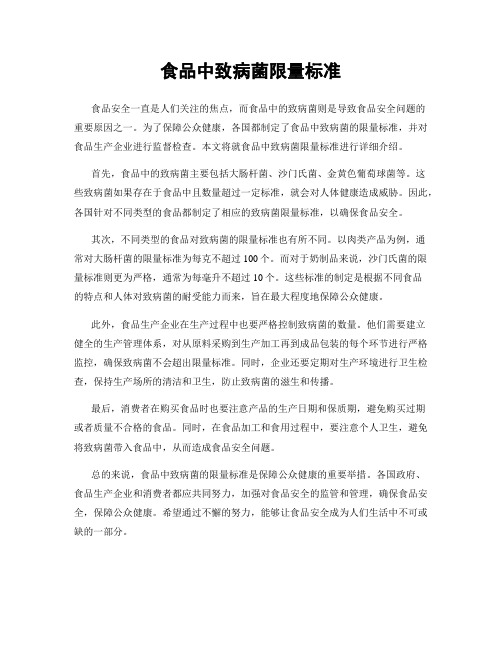
食品中致病菌限量标准食品安全一直是人们关注的焦点,而食品中的致病菌则是导致食品安全问题的重要原因之一。
为了保障公众健康,各国都制定了食品中致病菌的限量标准,并对食品生产企业进行监督检查。
本文将就食品中致病菌限量标准进行详细介绍。
首先,食品中的致病菌主要包括大肠杆菌、沙门氏菌、金黄色葡萄球菌等。
这些致病菌如果存在于食品中且数量超过一定标准,就会对人体健康造成威胁。
因此,各国针对不同类型的食品都制定了相应的致病菌限量标准,以确保食品安全。
其次,不同类型的食品对致病菌的限量标准也有所不同。
以肉类产品为例,通常对大肠杆菌的限量标准为每克不超过100个。
而对于奶制品来说,沙门氏菌的限量标准则更为严格,通常为每毫升不超过10个。
这些标准的制定是根据不同食品的特点和人体对致病菌的耐受能力而来,旨在最大程度地保障公众健康。
此外,食品生产企业在生产过程中也要严格控制致病菌的数量。
他们需要建立健全的生产管理体系,对从原料采购到生产加工再到成品包装的每个环节进行严格监控,确保致病菌不会超出限量标准。
同时,企业还要定期对生产环境进行卫生检查,保持生产场所的清洁和卫生,防止致病菌的滋生和传播。
最后,消费者在购买食品时也要注意产品的生产日期和保质期,避免购买过期或者质量不合格的食品。
同时,在食品加工和食用过程中,要注意个人卫生,避免将致病菌带入食品中,从而造成食品安全问题。
总的来说,食品中致病菌的限量标准是保障公众健康的重要举措。
各国政府、食品生产企业和消费者都应共同努力,加强对食品安全的监管和管理,确保食品安全,保障公众健康。
希望通过不懈的努力,能够让食品安全成为人们生活中不可或缺的一部分。
食品中致病菌限量相关标准
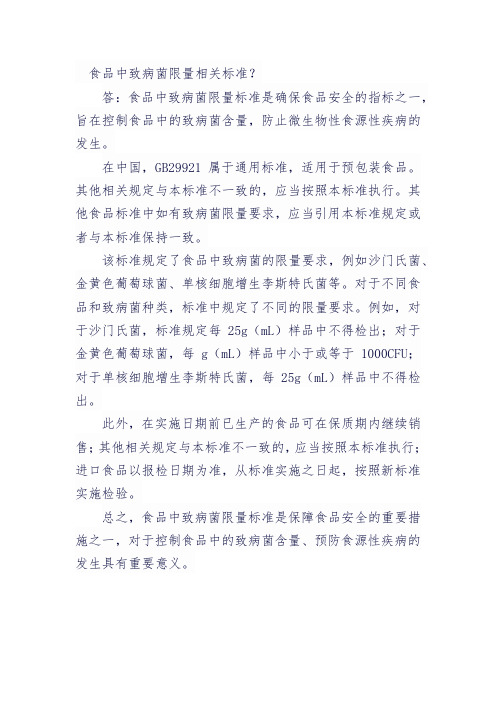
食品中致病菌限量相关标准?
答:食品中致病菌限量标准是确保食品安全的指标之一,旨在控制食品中的致病菌含量,防止微生物性食源性疾病的发生。
在中国,GB29921属于通用标准,适用于预包装食品。
其他相关规定与本标准不一致的,应当按照本标准执行。
其他食品标准中如有致病菌限量要求,应当引用本标准规定或者与本标准保持一致。
该标准规定了食品中致病菌的限量要求,例如沙门氏菌、金黄色葡萄球菌、单核细胞增生李斯特氏菌等。
对于不同食品和致病菌种类,标准中规定了不同的限量要求。
例如,对于沙门氏菌,标准规定每25g(mL)样品中不得检出;对于金黄色葡萄球菌,每g(mL)样品中小于或等于1000CFU;对于单核细胞增生李斯特氏菌,每25g(mL)样品中不得检出。
此外,在实施日期前已生产的食品可在保质期内继续销售;其他相关规定与本标准不一致的,应当按照本标准执行;进口食品以报检日期为准,从标准实施之日起,按照新标准实施检验。
总之,食品中致病菌限量标准是保障食品安全的重要措施之一,对于控制食品中的致病菌含量、预防食源性疾病的发生具有重要意义。
食品中致病菌限量标准
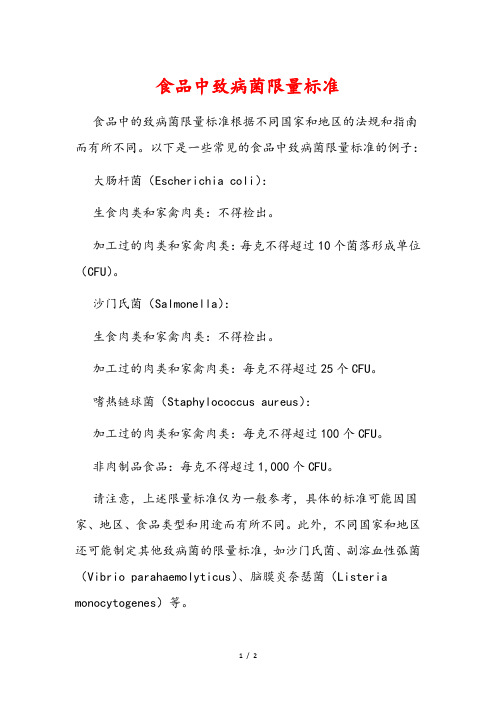
食品中致病菌限量标准
食品中的致病菌限量标准根据不同国家和地区的法规和指南而有所不同。
以下是一些常见的食品中致病菌限量标准的例子:大肠杆菌(Escherichia coli):
生食肉类和家禽肉类:不得检出。
加工过的肉类和家禽肉类:每克不得超过10个菌落形成单位(CFU)。
沙门氏菌(Salmonella):
生食肉类和家禽肉类:不得检出。
加工过的肉类和家禽肉类:每克不得超过25个CFU。
嗜热链球菌(Staphylococcus aureus):
加工过的肉类和家禽肉类:每克不得超过100个CFU。
非肉制品食品:每克不得超过1,000个CFU。
请注意,上述限量标准仅为一般参考,具体的标准可能因国家、地区、食品类型和用途而有所不同。
此外,不同国家和地区还可能制定其他致病菌的限量标准,如沙门氏菌、副溶血性弧菌(Vibrio parahaemolyticus)、脑膜炎奈瑟菌(Listeria monocytogenes)等。
为了确保食品安全,建议遵循当地食品安全机构和监管部门的指南和法规,并采取适当的食品处理和储存措施,以最大程度地减少致病菌的存在和传播。
食品安全国家标准食品中致病菌限量
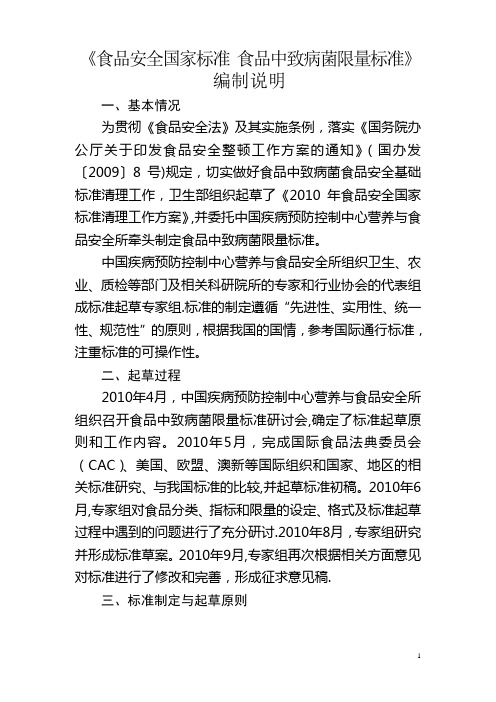
《食品安全国家标准食品中致病菌限量标准》编制说明一、基本情况为贯彻《食品安全法》及其实施条例,落实《国务院办公厅关于印发食品安全整顿工作方案的通知》(国办发〔2009〕8号)规定,切实做好食品中致病菌食品安全基础标准清理工作,卫生部组织起草了《2010年食品安全国家标准清理工作方案》,并委托中国疾病预防控制中心营养与食品安全所牵头制定食品中致病菌限量标准。
中国疾病预防控制中心营养与食品安全所组织卫生、农业、质检等部门及相关科研院所的专家和行业协会的代表组成标准起草专家组.标准的制定遵循“先进性、实用性、统一性、规范性”的原则,根据我国的国情,参考国际通行标准,注重标准的可操作性。
二、起草过程2010年4月,中国疾病预防控制中心营养与食品安全所组织召开食品中致病菌限量标准研讨会,确定了标准起草原则和工作内容。
2010年5月,完成国际食品法典委员会(CAC)、美国、欧盟、澳新等国际组织和国家、地区的相关标准研究、与我国标准的比较,并起草标准初稿。
2010年6月,专家组对食品分类、指标和限量的设定、格式及标准起草过程中遇到的问题进行了充分研讨.2010年8月,专家组研究并形成标准草案。
2010年9月,专家组再次根据相关方面意见对标准进行了修改和完善,形成征求意见稿.三、标准制定与起草原则(一)优先解决的主要矛盾。
本次工作重点是优先解决目前食品卫生标准、食品质量标准、行业标准、农产品质量标准间重复交叉问题.(二)标准的清理完善既要和国际通用原则接轨,又要考虑我国的实际情况.食品中致病菌限量标准在现有国家标准的基础上进行整理和完善。
(三)标准中涉及的食品分类尽可能与食品添加剂、食品污染物限量标准等基础标准的分类协调一致。
四、主要内容和依据(一)参考国际和相关国家标准,包括ICMSF、欧盟、澳大利亚、新西兰、美国、加拿大等国家和地区的食品中致病菌限量标准,同时充分考虑到我国的实际情况,注重标准的可操作性和一致性。
国家食品微生物限量标准

国家食品微生物限量标准
国家食品微生物限量标准是指在食品中允许存在的微生物的数量限制,以确保食品的质量和安全。
不同国家和地区的食品微生物限量标准可能有所不同,根据当地法律法规、卫生标准和食品安全要求制定。
常见的食品微生物限量标准包括以下几个方面:
1. 总菌落计数限量:表示食品中允许存在的总细菌数量的上限。
总菌落计数是指通过培养方法将食品中的细菌培育出来并计数。
2. 沙门氏菌限量:食品中不允许检出沙门氏菌,因为沙门氏菌是一种致病菌,可以引起食物中毒。
3. 大肠菌群限量:大肠菌群包括致病性大肠杆菌等菌种,其存在可能表示食品受到粪便污染,因此食品中允许存在的大肠菌群数量有一定限制。
4. 霉菌限量:食品中存在的霉菌数量也有一定限制。
霉菌的存在可能导致食品腐败、产生毒素等问题。
除了上述常见的微生物限量标准,不同食品可能还会有其他特定的微生物限量标准,比如嗜热菌、嗜盐菌、产气荚膜梭菌等。
这些限量标准的制定都旨在确保食品的质量和安全,保护消费者的健康。
食品微生物限量规定
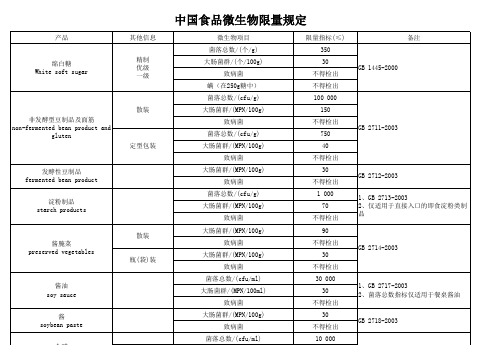
中国食品微生物限量规定
drinking water
次检验
dried aquatic products of
2、致病菌系指沙门氏菌、金黄色葡萄
2、若非指定,以cfu/g或cfu/ml表示condensed milk and formulated
菌
1、GB 14891.4-1997
如无特别说明,致病菌系指沙门氏菌、志贺氏菌、金黄色葡萄球菌
n/c/m/M:
n:同一批次产品应采集的样品件数;
c:最大可允许超出m值得样品数;
m:微生物指标可接受水平的限量值;
M:微生物指标的最高安全限量值。
注1:按照二级采样方案设定的指标,在n个样品中,允许有≤c个样品其相应微生物指标检验值大于m值。
注2:按照三级采样方案设定的指标,在n个样品中,允许全部样品中相应微生物指标检验值≤m值;允许有≤c个样品其相应微生物指标检验值在m值和M值之间;不允许有样品相应微生物指标检验值大于M值。
例如:n/c/m/M为5/2/(1 000 cfu/g)/(10 000 cfu/g),含义是从一批次中采集5个样品,若5个样品的检验结果均小于或等于m值(≤1 000 cfu/g),则判定为合格;若≤2个样品的结果(X)位于m值和M值之间(1 000 cfu/g<X≤10 000 cfu/g),则判定为合格;若有3个及以上样品的检验结果位于m值和M值之间,则判定为不合格;若有任一个样品的检验结果大于M值(>10 000 cfu/g),则判定为不合格。
食品中致病菌及其限量标准

食品中致病菌及其限量标准1食品致病菌的概念食物污染后可在食品中生长繁殖并可引起人或动物疾病的细菌称为食品致病菌。
食品致病菌可通过直接或间接途径污染食品及水源,人经口摄入可导致肠道传染病、食物中毒等食源性疾病的发生。
食品中主要的致病菌有沙门氏菌、金黄色葡萄球菌、副溶血性弧和致病性大肠杆等。
2常见致病菌及其主要污染食品1.沙门氏菌沙门氏菌(salmonella)亦称沙门菌,是肠杆菌科的一个重要菌属,为革兰阴性杆菌,需氧或兼性厌氧,大多具有周身鞭毛,能运动,在7℃~45℃条件下均可生长,最适温度为35℃~37℃。
沙门菌对干燥、腐败、日光等因素具有一定的抵抗力,在自然环境中可以生存数周或数月。
多数沙门菌的宿主特异性极弱,既可感染动物也可以感染人,故易引起人类的食物中毒。
沙门菌血清型很多,引起食物中毒最常见是鼠伤寒沙门菌、猪霍乱沙门菌、都柏林沙门菌、德尔卑沙门菌、肠炎沙门菌等。
沙门菌可污染各种食品,尤其是动物性食品。
其污染食品后一般无感官性状的变化故对贮存较久的食品,即使没有明显的腐败变质,也应注意彻底加热灭菌,以防引起食物中毒。
2.副溶血性弧菌副溶血性弧菌(Vibrio Para hemolyticus)系弧菌科弧菌属,为革兰染色阴性的多形态杆菌或微弯曲弧菌,无芽孢。
该菌嗜盐畏酸,在温度30℃~37℃,含盐3%~4%,pH值为7.4~8.2的培养基中生长良好,低于0.5%或高于8%盐水中停止生长。
副溶血性弧菌存活能力强,在抹布和砧板上能生存1个月以上。
副溶血弧菌广泛存在于近岸海水、海底沉积物和鱼、贝类等海产品中,故海产品是引起副溶血性弧菌食物中毒的主要食品。
另外,在盐分较高的腌制食品,如咸菜、腌肉等也可检出副溶血弧菌。
3.致病性大肠杆菌大肠杆菌亦称大肠埃希氏菌(Escherichia),是人类和大多数温血动物肠道中的正常菌群,通常不致病。
但也有某些血清型的大肠杆菌有不同程度的致病性,称为致病性大肠杆菌。
食品中致病菌限量标准中的ncmM

食品中致病菌限量标准中的n c m M微生物采样计划限量值(样品数,以“件”表示)(不指定,用cfu/g或cfu/mL)n c m Ms菌落总数 5 2 300 3000大肠菌群 5 2 10 100一、n、c、m和M的说明n:系指一批产品采样个数。
c:系指该批产品的检样菌数中,超过限量的检样数,即结果超过合格菌数限量的最大允许数。
m:系指合格菌数限量,将可接受与不可接受的数量区别开。
M:系指附加条件,判定为合格的菌数限量,表示边缘的可接受数与边缘的不可接受数之间的界限。
二、以菌落总数和大肠菌群为例说明:样品数为5个。
1、若所有的样品的菌落总数均小于300个,大肠菌群均小于10,合格。
2、若样品的菌落总数有一个大于3000个,大肠菌群有一个大于100个,不合格,3、若样品的菌落总数有2个在300-3000间,其它样品的菌落总数小于300个,大肠菌群有2个在10-100间,其它样品的大肠菌群小于10个,合格。
4、若样品的菌落总数有2个以上在300-3000间,大肠菌群有2个以上在10-100间,不合格。
二级法只设有n、с及m值,三级法则有n、c、m及M值。
M即附加条件后判定合格的菌数限量值。
自然界中材料的分布曲线一般是正态分布,以其一点作为食品微生物的限量值,只设合格判定标准m值,超过m值的,则为不合格品,这是二级抽样方案。
设有微生物标准m及M值两个限量如同二级法,超过m值的检样,即算为不合格品。
其中以m值到M值的范围内的检样数,作为c值,如果在此范围内,即为附加条件合格,超过M值者,则为。
餐饮食品致病菌要求地方标准

餐饮食品致病菌要求地方标准一、术语和定义1.餐饮食品:本标准所称餐饮食品,是指餐饮服务单位(含集体用餐配送单位)在生产和供应过程中,经口摄入食道的即食和可食用食品,包括主食、菜肴、肉类、乳制品、水果、饮品等。
2.致病菌:本标准所称致病菌,是指可引起食源性疾病的微生物,包括沙门氏菌、副溶血性弧菌、金黄色葡萄球菌、大肠埃希氏菌等。
二、食品分类1.根据食品种类和特性,分为以下四类:2.a) 热菜类:包括中式菜肴、西式菜肴等;3.b) 凉菜类:包括凉拌菜、刺身等;4.c) 糕点类:包括面包、蛋糕、饼干等;5.d) 饮品类:包括果汁、茶饮、咖啡等。
6.根据食品加工方式,分为以下两类:7.a) 即食食品:指在餐饮服务现场供消费者直接食用的食品;8.b) 非即食食品:指在餐饮服务现场供消费者加工食用的食品。
三、检测方法及判定标准1.致病菌检测方法应按照国家相关标准、法规和规定执行。
2.判定标准应符合以下要求:3.a) 不得检出致病菌;4.b) 若检出致病菌,应判定为不合格。
四、食品中致病菌限量1.即食食品中致病菌限量应符合以下要求:2.a) 沙门氏菌:不得检出;3.b) 副溶血性弧菌:不得检出;4.c) 金黄色葡萄球菌:不得检出;5.d) 大肠埃希氏菌:每100g不得检出。
6.非即食食品中致病菌限量应符合以下要求:7.a) 沙门氏菌:每100g不得检出;8.b) 副溶血性弧菌:每100g不得检出;9.c) 金黄色葡萄球菌:每100g不得检出;10.d) 大肠埃希氏菌:每100g不得检出。
五、食品生产、加工、贮存、运输过程中的预防措施1.食品生产单位应建立完善的质量控制体系,确保产品质量安全。
2.食品加工过程中应严格执行卫生操作规程,避免交叉污染。
3.食品贮存应采取适当的温度和湿度控制措施,确保食品新鲜度和质量安全。
4.食品运输过程中应采取必要的防护措施,防止食品污染和变质。
六、监管与处罚1.监管部门应对餐饮服务单位实施监督检查,发现不符合标准的,应依法进行处理。
微生物限量标准

微生物中文名食品中文名限量使用限制及备注中文数据采纳日期大肠菌群制冰厂及零售点的冰块(包装冰)0/100mL瓶装水、可食用冰及非瓶装饮料微生物含量限值。
2009.4埃希氏大肠杆菌制冰厂及零售点的冰块(包装冰)0/100mL瓶装水、可食用冰及非瓶装饮料微生物含量限值。
2009.4需氧菌落计数制冰厂及零售点的冰块(包装冰)<500/mL瓶装水、可食用冰及非瓶装饮料微生物含量限值。
2009.4菌落总数植物蛋白饮料≤100(cfu/ml)2003大肠菌群植物蛋白饮料≤3(MPN/100ml)2003致病菌(沙门氏菌、志贺氏菌、金黄色葡萄球菌)植物蛋白饮料不得检出2003霉菌、酵母植物蛋白饮料≤20(cfu/ml)2003菌落总数鱼糜和虾糜制品≤3000(cfu/g)即食类2005大肠菌群鱼糜和虾糜制品≤30(MPN/100g)即食类2005致病菌(沙门氏菌、金黄色葡萄球菌、志贺氏菌)鱼糜和虾糜制品不得检出即食类2005菌落总数鱼糜和虾糜制品≤50000(cfu/g)非即食类2005大肠菌群鱼糜和虾糜制品≤450(MPN/100g)非即食类2005致病菌(沙门氏菌、金黄色葡萄球菌、志贺氏菌)鱼糜和虾糜制品不得检出非即食类2005微生物鱼罐头符合罐头食品商业无菌要求2005菌落总数油炸小食品类≤1000(cfu/ml)2003大肠菌群油炸小食品类≤30(MPN/100ml)2003致病菌(沙门氏菌、志贺氏菌、金黄色葡萄球菌)油炸小食品类不得检出2003菌落总数婴幼儿配方粉及婴幼儿补充谷粉≤30000(cfu/g)婴儿配方粉1997大肠菌群婴幼儿配方粉及婴幼儿补充谷粉≤40/(MPN/100g)婴儿配方粉1997致病菌(肠道致病菌及致病球菌)婴幼儿配方粉及婴幼儿补充谷粉不得检出婴儿配方粉1997酵母和霉菌婴幼儿配方粉及婴幼儿补充谷粉≤50(cfu/g)婴儿配方粉1997菌落总数婴幼儿配方粉及婴幼儿补充谷粉≤30000(cfu/g)(即食类)≤50000(cfu/g)(非即食类)婴幼儿补充谷粉1997大肠菌群婴幼儿配方粉及婴幼儿补充谷粉≤40/(MPN/100g)(即食类)≤90/(MPN/100g)(非即食类)婴幼儿补充谷粉1997致病菌(肠道致病菌及致病球菌)婴幼儿配方粉及婴幼儿补充谷粉不得检出婴幼儿补充谷粉1997酵母和霉菌婴幼儿配方粉及婴幼儿补充谷粉≤50(cfu/g)婴幼儿补充谷粉1997菌落总数婴幼儿配方粉及婴幼儿补充谷粉≤30000(cfu/g)较大婴儿和幼儿配方粉1997大肠菌群婴幼儿配方粉及婴幼儿补充谷粉≤40/(MPN/100g)较大婴儿和幼儿配方粉1997致病菌(肠道致病菌及致病球菌)婴幼儿配方粉及婴幼儿补充谷粉不得检出较大婴儿和幼儿配方粉1997酵母和霉菌婴幼儿配方粉及婴幼儿补充谷粉≤50(cfu/g)较大婴儿和幼儿配方粉1997微生物婴幼儿辅助食品—肉泥无致病菌及因微生物作用所引起的腐败象征1989微生物婴幼儿辅助食品—苹果泥无致病菌及因微生物作用所引起的腐败象征1989微生物婴幼儿辅助食品—鸡肉菜糊无致病菌及因微生物作用所引起的腐败象征1989微生物婴幼儿辅助食品—胡萝卜泥无致病菌及因微生物作用所引起的腐败象征1989微生物婴幼儿辅助食品—骨泥无致病菌及因微生物作用所引起的腐败象征1989菌落总数婴幼儿辅助食品—番茄汁≤80(cfu/g)1989大肠菌群婴幼儿辅助食品—番茄汁≤3/(MPN/100g)1989致病菌(沙门氏菌、志贺氏菌、葡萄球菌)婴幼儿辅助食品—番茄汁不得检出1989霉菌婴幼儿辅助食品—番茄汁≤40cfu/g或cfu/mL1989菌落总数婴幼儿断奶期辅助食品≤30000(cfu/g)即食类1997大肠菌群婴幼儿断奶期辅助食品≤40/(MPN/100g)即食类1997致病菌(肠道致病菌及致病球菌)婴幼儿断奶期辅助食品不得检出即食类1997菌落总数婴幼儿断奶期辅助食品≤50000(cfu/g)非即食类1997大肠菌群婴幼儿断奶期辅助食品≤90/(MPN/100g)非即食类1997致病菌(肠道致病菌及致病球菌)婴幼儿断奶期辅助食品不得检出非即食类1997菌落总数婴幼儿断奶期补充食品≤30000(cfu/g)即食类1997大肠菌群婴幼儿断奶期补充食品≤40/(MPN/100g)即食类1997致病菌(肠道致病菌及致病球菌)婴幼儿断奶期补充食品不得检出即食类1997菌落总数婴幼儿断奶期补充食品≤50000(cfu/g)非即食类1997大肠菌群婴幼儿断奶期补充食品≤90/(MPN/100g)非即食类1997致病菌(肠道致病菌及致病球菌)婴幼儿断奶期补充食品不得检出非即食类1997菌落总数婴儿配方乳粉Ⅰ≤30000(cfu/g)1997大肠菌群婴儿配方乳粉Ⅰ≤40/(MPN/100g)1997致病菌(肠道致病菌及致病球菌)婴儿配方乳粉Ⅰ不得检出1997酵母和霉菌婴儿配方乳粉Ⅰ≤50(cfu/g)1997菌落总数婴儿配方粉Ⅱ,Ⅲ≤30000(cfu/g)1997大肠菌群婴儿配方粉Ⅱ,Ⅲ≤40/(MPN/100g)1997致病菌(肠道致病菌及致病球菌)婴儿配方粉Ⅱ,Ⅲ不得检出1997酵母和霉菌婴儿配方粉Ⅱ,Ⅲ≤50(cfu/g)1997大肠菌群饮用天然矿泉水≤0(MPN/100ml)1个样品,如果检测结果为0合格;检测结果大于等于1但小于2时,进行第二次检测;检测结果大于等于2,不合格。
食品国家安全标准gb24154

食品国家安全标准gb24154一、范围本标准规定了食品中致病菌限量、重金属、农药残留、兽药残留、食品添加剂、污染物、放射性物质以及其他危害人体健康物质的限量要求。
本标准适用于我国境内生产、销售的预包装食品和散装食品。
二、术语和定义下列术语和定义适用于本标准。
1. 食品:指各种供人食用或者饮用的成品和原料以及按照传统既是食品又是药品的物品,但不包括以治疗为目的的物品。
2. 预包装食品:指在预先定量包装的食品,包括预先定量包装的食品添加剂。
3. 散装食品:指不在预先定量包装的食品。
三、限量要求1. 致病菌限量要求(1)菌落总数:不得检出。
(2)大肠埃希氏菌:不得检出。
(3)金黄色葡萄球菌:不得检出。
(4)沙门氏菌:不得检出。
(5)其他致病菌:按照GB29921执行。
2. 重金属限量要求(1)铅:≤0.1mg/kg。
(2)镉:≤0.05mg/kg。
(3)汞:≤0.5mg/kg。
(4)砷:≤0.1mg/kg。
3. 农药残留限量要求按照GB2763执行。
4. 兽药残留限量要求按照GB31650执行。
5. 食品添加剂限量要求按照GB2760执行。
6. 污染物限量要求(1)多氯联苯:≤0.5mg/kg。
(2)二噁英:≤4pgTEQ/kg。
(3)苯并[a]芘:≤5μg/kg。
7. 放射性物质限量要求按照GB14882执行。
8. 其他危害人体健康物质限量要求按照相关国家食品安全标准执行。
四、检验方法本标准所涉及的检验方法按照国家相关食品安全标准执行。
五、包装和标识1. 食品包装应采用无毒、清洁、干燥的材料,并符合国家有关包装材料的规定。
2. 食品标识应清晰、真实、准确,包括以下内容:(1)食品名称。
(2)配料表。
(3)净含量。
(4)生产日期或批号。
(5)保质期。
(6)贮存条件。
(7)生产者名称和地址。
(8)产品标准代号。
(9)其他需要标识的内容。
六、运输和贮存1. 食品的运输和贮存应遵循以下原则:(1)防止食品受到污染。
食品菌落总数限量标准
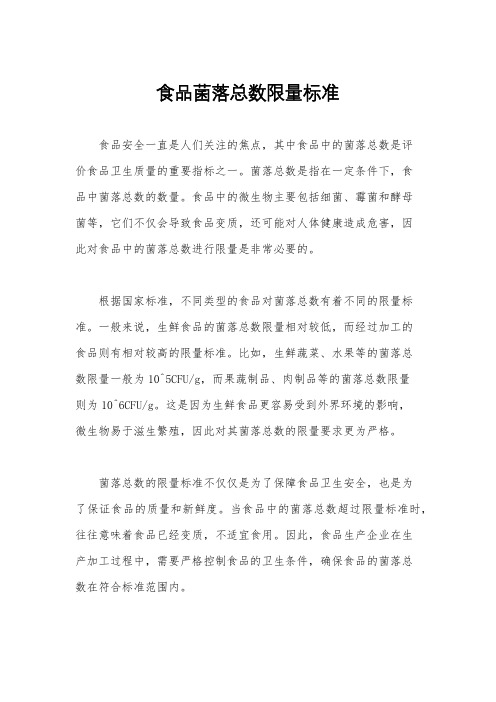
食品菌落总数限量标准
食品安全一直是人们关注的焦点,其中食品中的菌落总数是评
价食品卫生质量的重要指标之一。
菌落总数是指在一定条件下,食
品中菌落总数的数量。
食品中的微生物主要包括细菌、霉菌和酵母
菌等,它们不仅会导致食品变质,还可能对人体健康造成危害,因
此对食品中的菌落总数进行限量是非常必要的。
根据国家标准,不同类型的食品对菌落总数有着不同的限量标准。
一般来说,生鲜食品的菌落总数限量相对较低,而经过加工的
食品则有相对较高的限量标准。
比如,生鲜蔬菜、水果等的菌落总
数限量一般为10^5CFU/g,而果蔬制品、肉制品等的菌落总数限量
则为10^6CFU/g。
这是因为生鲜食品更容易受到外界环境的影响,
微生物易于滋生繁殖,因此对其菌落总数的限量要求更为严格。
菌落总数的限量标准不仅仅是为了保障食品卫生安全,也是为
了保证食品的质量和新鲜度。
当食品中的菌落总数超过限量标准时,往往意味着食品已经变质,不适宜食用。
因此,食品生产企业在生
产加工过程中,需要严格控制食品的卫生条件,确保食品的菌落总
数在符合标准范围内。
除了食品生产企业的责任外,消费者在购买食品时也要注意食品的卫生安全。
选择新鲜、包装完好的食品是保证食品卫生的重要途径之一。
同时,消费者在食用食品时,也要注意储存和加热,避免食品受到二次污染,保证食品的卫生安全。
总的来说,食品菌落总数限量标准是保障食品卫生安全和质量的重要手段之一。
食品生产企业和消费者都应该共同努力,遵守相关标准和规定,确保食品的卫生安全,为人们的健康保驾护航。
GB_29921-2021《食品安全国家标准_预包装食品中致病菌限量》浅析

标准评析GB 29921-2021《食品安全国家标准 预包装食品中致病菌限量》浅析■ 匡燕云1,2 马淑棉1,2 牛 娜1,2 涂晓波1,2 赖家豪1,2 李俊妮3 金晓蕾1,2(1.深圳海关食品检验检疫技术中心;2.深圳市检验检疫科学研究院;3.深圳市计量质量检测研究院)摘 要:GB 29921-2021《食品安全国家标准 预包装食品中致病菌限量》已实施一年多,新标准整合了分散在不同食品标准中的致病菌限量规定, 修改了标准名称、适用范围、应用原则,增加了食品类别,对控制食品中致病菌污染,预防微生物性食源性疾病发生具有重要的意义。
本文通过与国内外相关标准的比较,对《食品安全国家标准 预包装食品中致病菌限量》(GB 29921-2021)的适用范围、采样方案进行了分析,重点归纳分析了6种致病菌限量指标的变化及其特点,并提出了相关建议。
关键词:食品安全,国家标准,致病菌限量DOI编码:10.3969/j.issn.1002-5944.2023.20.025Brief Analysis of GB 29921-2021, National standard for food safety—Pathogens standard for prepackaged food sKUANG Yan-yun1, 2 MA Shu-mian1, 2 NIU Na1, 2 TU Xiao-bo1, 2LAI Jia-hao1, 2 LI Jun-ni3 JIN Xiao-lei1, 2(1. Shenzhen Customs Food Inspection and Quarantine Technology Center;2. Shenzhen Academy of Inspection and Quarantine;3. Shenzhen Academy of Metrology and Quarantine Inspection)Abstract:GB 29921-2021, National standard for food safety—Pathogens standard for prepackaged foods, has been implemented for more than one year. The new standard integrates the limits of pathogenic bacteria scattered in different food standards, modifies the name of the standard, the applicable scope and application principles, and adds food categories. It is of great signifi cance to control the contamination of pathogenic bacteria in food and prevent microbial foodborne illness. This article analyzes the applicable scope and sampling plan of GB 29921-2021 by comparing it with relevant domestic and international standards, and mainly summarizes and analyzes the changes and characteristics of the limit indicators of six pathogenic bacteria, and proposes relevant suggestions.Keyword: food safety, national standard, pathogens standard for prepackaged foods0 引 言随着我国经济社会的发展和生活水平的提高,人们对食品安全越来越重视。
《GB 29921-2013 食品中致病菌限量》标准解读

主要考虑的因素 致病菌对健康的危害 原料的致病菌状况 加工操作过程对 致病菌状况的影响 消费人群状况 其他因素(成本-效益)
肉制品
8
乳制品
6
蛋制品
1
水产品
3
果蔬(豆、菌) 5
粮食制品
6
婴幼儿食品 10
微生物限量,1981-2003,83
干果
2
调味品
11
饮料
9
酒
1
饮用水
2
糖果、小食品 9
油脂
4
其他
A microbiological criterion should be practical and feasible and established only when necessary.
The purpose of establishing and applying a microbiological criterion should be clearly articulated.
But we must appreciate the nature of existence.
Strict specifications do not produce safe foods. Need strict process controls that elimination hazards Without process, the specification is meaningless
关于致病菌 微生物限量标准制定的主要原则 我国致病菌限量标准现状 GB29921制定的背景 GB29921的主要内容 与当前标准相比的主要变化 实施GB29921过程中的注意事项
微生物
致病菌
食品安全控 制指标之一
食品中微生物限量标准
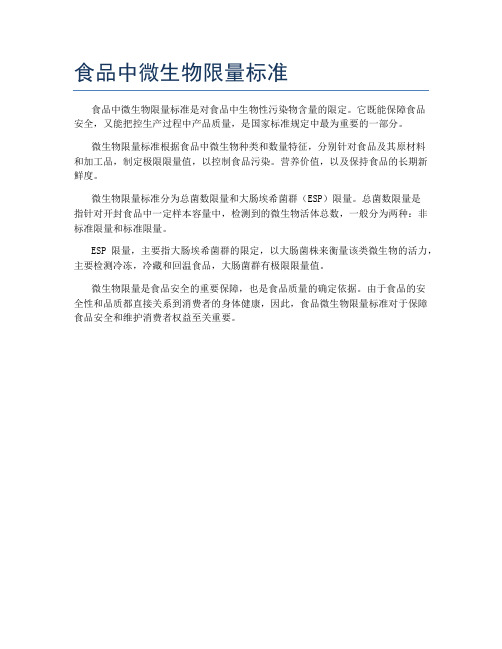
食品中微生物限量标准
食品中微生物限量标准是对食品中生物性污染物含量的限定。
它既能保障食品
安全,又能把控生产过程中产品质量,是国家标准规定中最为重要的一部分。
微生物限量标准根据食品中微生物种类和数量特征,分别针对食品及其原材料
和加工品,制定极限限量值,以控制食品污染。
营养价值,以及保持食品的长期新鲜度。
微生物限量标准分为总菌数限量和大肠埃希菌群(ESP)限量。
总菌数限量是
指针对开封食品中一定样本容量中,检测到的微生物活体总数,一般分为两种:非标准限量和标准限量。
ESP限量,主要指大肠埃希菌群的限定,以大肠菌株来衡量该类微生物的活力,主要检测冷冻,冷藏和回温食品,大肠菌群有极限限量值。
微生物限量是食品安全的重要保障,也是食品质量的确定依据。
由于食品的安
全性和品质都直接关系到消费者的身体健康,因此,食品微生物限量标准对于保障食品安全和维护消费者权益至关重要。
《食品中致病菌限量》(GB29921-2013)问答
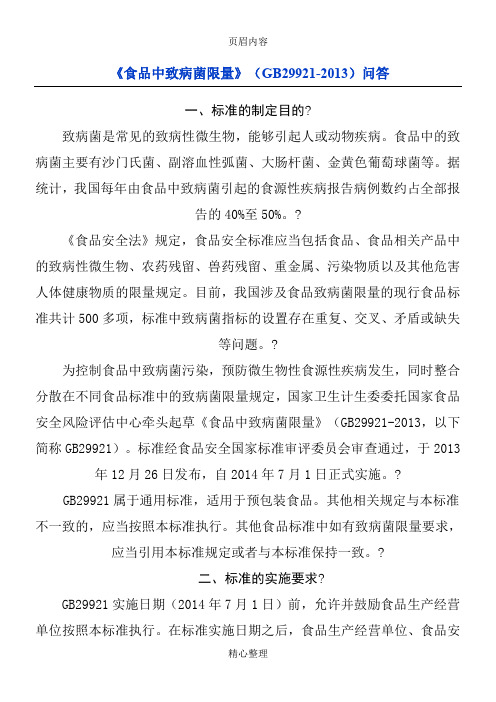
《食品中致病菌限量》(GB29921-2013)问答一、标准的制定目的?致病菌是常见的致病性微生物,能够引起人或动物疾病。
食品中的致病菌主要有沙门氏菌、副溶血性弧菌、大肠杆菌、金黄色葡萄球菌等。
据不一致的,应当按照本标准执行。
其他食品标准中如有致病菌限量要求,应当引用本标准规定或者与本标准保持一致。
?二、标准的实施要求?GB29921实施日期(2014年7月1日)前,允许并鼓励食品生产经营单位按照本标准执行。
在标准实施日期之后,食品生产经营单位、食品安全监管机构和检验机构应按照本标准执行。
在实施日期前已生产的食品可在保质期内继续销售。
进口食品的标准执行时间应按照相关规定执行。
致病菌检验应按照GB29921引用的检验方法执行。
?食品生产经营者应当严格执行食品生产经营规范标准或采取相应控制措施,严格生产经营过程的微生物控制,确保产品符合GB29921规定。
?(三)参考国外评估结果和标准,完善标准规定。
GB29921参考了相关国际组织致病菌风险评估结果和标准规定,包括国际食品法典委员会(CAC)食品微生物标准的制定和应用原则、联合国粮农组织/世界卫生组织食品微生物风险评估专家委员会评估报告、国际食品微生物标准委员会(ICMSF)微生物危害及其潜在风险分析及分级采样方案等。
标准还借鉴了美国、欧盟、澳大利亚和新西兰、日本、加拿大等国家和地区食品中致病菌限量标准规定。
?(四)广泛听取意见,做到公开透明。
标准起草过程中多次召开研讨会,听取相关部门、研究机构、行业协会和企业意见,两次通过国家卫生计生委网站向社会公开征求意见并向世贸组织成员通报,在分析反馈意见熏、烤、腌、蒸、煮等任何一种或多种加工方法制成的直接可食的肉类加工制品。
即食生肉制品指以畜、禽等肉为主要原料经发酵或特殊工艺加工制成的直接可食的生肉制品。
?(二)水产制品。
GB29921中的水产制品包括熟制水产品、即食生制水产品和即食藻类制品。
熟制水产品指以鱼类、甲壳类、贝类、软体类、棘皮类等动物性水产品为主要原料,经蒸、煮、烘烤、油炸等加热熟制过程制成的直接食用的水产加工制品。
食品中致病菌限量问答.总结

食品中致病菌限量问答1. 什么是致病菌?致病菌指能够引起细菌、病毒或其他微生物感染的微生物。
在食品中,常见的致病菌包括大肠杆菌、沙门氏菌、金黄色葡萄球菌、肺炎克雷伯菌等。
这些菌将食品污染后,如果未经彻底加工,可能通过口腔、呼吸道、消化道等途径进入人体,使人体产生不良反应,甚至引起重大疾病。
2. 为什么要限制食品中致病菌的存在?限制食品中致病菌的存在,是为了保障人类的健康安全。
食品是人类生活中必不可少的东西,如果其中存在大量的致病菌,就会让人们更容易感染疾病,给健康造成极大的威胁。
3. 食品中致病菌的限量标准是什么?在中国,食品中致病菌的限量标准由《食品安全国家标准食品中微生物限量》(GB 4789.2-2016)规定。
该标准明确了食品中各种致病菌的检测方法和限量标准,例如生熟肉中大肠杆菌的限量标准为不得检出。
4. 所有食品中的致病菌的限量标准都一样吗?不是。
不同的食品因其生产工艺和食品特性的不同,对致病菌的限量标准也不同。
以大肠杆菌为例,当它出现在大豆制品、豆腐制品、鲜牛奶、酱油等食品中时,检测方法和限量标准是不同的,因此需要进行相应的检测。
5. 常见的致病菌有哪些,它们会引起哪些疾病?常见的致病菌包括大肠杆菌、沙门氏菌、金黄色葡萄球菌、肺炎克雷伯菌等。
不同的致病菌会引起不同的疾病,如大肠杆菌可以引起腹泻、溶血性尿毒症综合症等,沙门氏菌可以引起沙门菌病、副伤寒等,金黄色葡萄球菌可以引起食物中毒、葡萄球菌病等。
6. 我们该如何避免食品中致病菌的污染?避免食品中的致病菌污染,需要首先保证食品的来源安全,选择正规的生产商和销售商。
其次,需要控制食品的加工和存储过程,严格遵守生产工艺和卫生标准。
在食用食品前,需要彻底烹煮或加工,并保持个人卫生,保证用餐环境卫生。
7. 食品中致病菌的检测需要注意哪些问题?关于食品中致病菌的检测,需要注意以下几点问题:•抽样方法:应该从不同的位置、时间、批次进行抽样,确保样本的代表性。
- 1、下载文档前请自行甄别文档内容的完整性,平台不提供额外的编辑、内容补充、找答案等附加服务。
- 2、"仅部分预览"的文档,不可在线预览部分如存在完整性等问题,可反馈申请退款(可完整预览的文档不适用该条件!)。
- 3、如文档侵犯您的权益,请联系客服反馈,我们会尽快为您处理(人工客服工作时间:9:00-18:30)。
主要考虑的因素 致病菌对健康的危害 原料的致病菌状况 加工操作过程对 致病菌状况的影响 消费人群状况 其他因素(成本-效益)
肉制品
8
乳制品
6
蛋制品
1
水产品
3
果蔬(豆、菌) 5
粮食制品
6
婴幼儿食品 10
微生物限量,1981-2003,83
干果
2
调味品
11
饮料
9
酒
1
饮用水
2
糖果、小食品 9
油脂
4
其他
Organisms in nature are not equally distributed.
It is easy so fail detecting pathogens in food simply because they not in the sample. We can improve testing and sampling methods. Human logic again, and helpful.
A food is tested It is negative for a kind of pathogen (salmonella) Therefore salmonella is absent This is human logic, not microbiology.
We must improve the understanding of microbiology Consider how these organisms exist. Appreciate the diversity and variability.
But we must appreciate the nature of existence.
Strict specifications do not produce safe foods. Need strict process controls that elimination hazards Without process, the specification is meaningless
6
10
致病菌限量,63
致病菌
0 (5);不得检出(12)
肠道致病菌
3Hale Waihona Puke 个/100g(1);不得检出(23)
致病性球菌
30个/100g(1);不得检出(23)
沙门氏(不得检出,62) 志贺氏菌(不得检出,62) 金黄色葡萄球菌(不得检出,61)
11
公共卫生现况
食源性疾病是真正需要关注的食品安全问题,致病菌是引起食源性疾 病的主要原因之一 在发达国家每年报告患食源性疾病的人数的比例高达30%。据美国CDC 的统计,美国每年约发生7600万例食源性疾病,其中约32.5万入院治 疗,有约5000人死亡。 全球每年仅5岁以下儿童的腹泻病例就达15亿例次,造成约300万儿童 死亡,其中70%是由各类致病微生物污染了食品或饮水所致。
分布广泛、种类繁多
无孔不入 50-600万种(植物约50万种、动物约150万种)
生长繁殖快、代谢能力强
大肠杆菌:三代/小时;24小时可达47×1022个,绕地球一周 比表面积大,代谢反应快
遗传稳定性差、易发生变异
易受不良环境影响
Domenic Caravetta
People have a strong desire to treat microbiology results as very absolute and fully representing a food.
The required stringency of a microbiological criterion used should be appropriate to its intended purpose.
Periodic reviews of microbiological criteria should be conducted, as appropriate, in order to ensure that microbiological criteria continue to be relevant to the stated purpose under current conditions and practices.
关于致病菌 微生物限量标准制定的主要原则 我国致病菌限量标准现状 GB29921制定的背景 GB29921的主要内容 与当前标准相比的主要变化 实施GB29921过程中的注意事项
微生物
致病菌
食品安全控 制指标之一
影响人 体健康
个体微小、结构简单,肉眼不可见或看不清楚
原核微生物 真核微生物 不具细胞结构的
The establishment of microbiological criteria should be based on scientific information and analysis and follow a structured and transparent approach.
Microbiological criteria should be established based on knowledge of the microorganisms and their occurrence and behavior along the food chain.
The intended as well as the actual use of the final product by consumers needs to be considered when setting a microbiological criterion.
A microbiological criterion should be practical and feasible and established only when necessary.
The purpose of establishing and applying a microbiological criterion should be clearly articulated.
CAC/GL 21
A microbiological criterion should be appropriate to protect the health of the consumer and where appropriate, also ensure fair practices in food trade.
